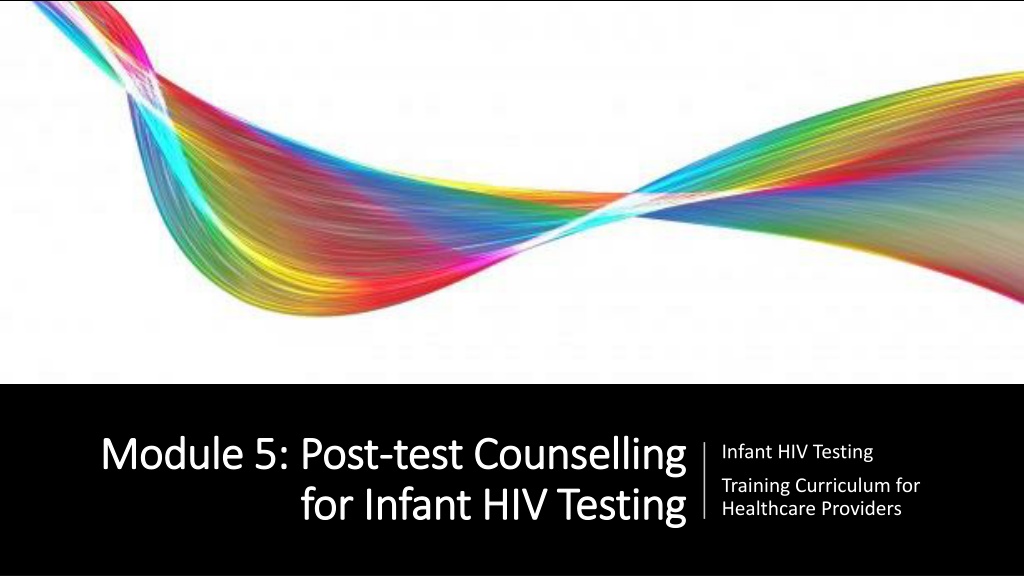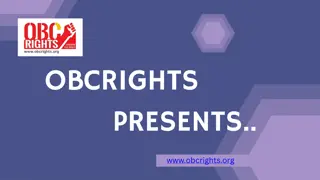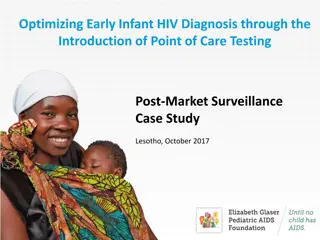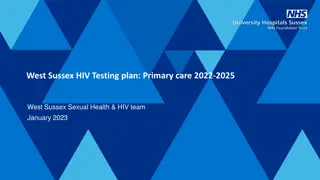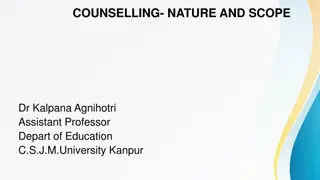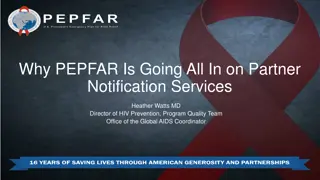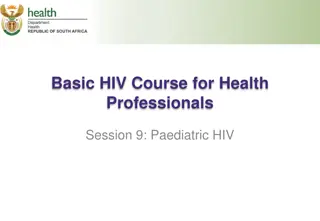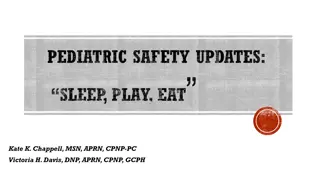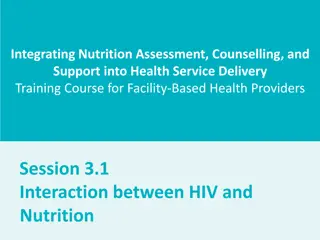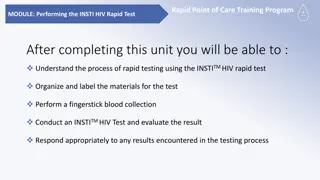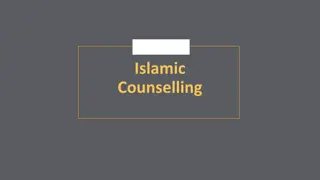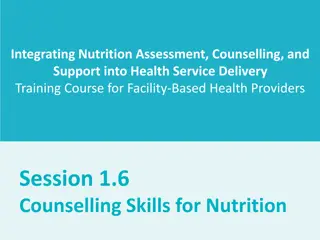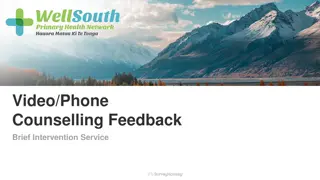Infant HIV Testing Post-Test Counselling Overview
This module provides guidance on conducting post-test counselling sessions for infants and children who test HIV-negative through diagnostic testing. It covers topics, procedures, and timelines for delivering the test results to caregivers in a healthcare setting.
Download Presentation

Please find below an Image/Link to download the presentation.
The content on the website is provided AS IS for your information and personal use only. It may not be sold, licensed, or shared on other websites without obtaining consent from the author. Download presentation by click this link. If you encounter any issues during the download, it is possible that the publisher has removed the file from their server.
E N D
Presentation Transcript
Module 5: Post Module 5: Post- -test Counselling test Counselling for Infant HIV Testing for Infant HIV Testing Infant HIV Testing Training Curriculum for Healthcare Providers
Session 5.1: HIV-negative Test Result, Post- test Counselling Session Session Objective Conduct the post-test counselling session for an infant or child under 18 months of age who tests HIV-negative by NAT or a child 18 months of age or older who tests HIV-negative by RDT
Diagnostic Testing for HIV Diagnostic Testing for HIV This module offers an overview of the post-test session for HIV diagnostic testing in infants and children who are HIV-exposed Diagnostic testing for HIV refers to a test that is used to find out if someone has HIV or not: Infants and children under 18 months of age: diagnostic test for HIV is NAT Children 18 months of age or older: diagnostic test is RDT RDT is not used before 18 months of age, unless: Assessing exposure status if the mother is not available, or It is part of presumptive HIV diagnosis in sick children where NAT is not available Guidance on the post-test session for infants under 18 months tested using RDT is in Appendix 5A
Overview of the HIV Overview of the HIV- -negative Post negative Post- -test Session test Session Post-test counselling session in the infant HIV testing setting is when the provider gives the caregiver the child s HIV test result Post-test session is given as soon as possible after receipt of test results: On the same day as visit if using RDT or point-of-care NAT, or Within 2 4 weeks if samples were sent to an outside laboratory (e.g., NAT) Whether breastfed or not, regardless of age, or type of test the post-test counselling session for a negative test result follows the same steps
Overview of the HIV Overview of the HIV- -negative Post negative Post- -test Session test Session What topics need to be discussed during the post-test session for the baby testing HIV-negative by nucleic acid testing (NAT) at the first follow-up visit?
Overview of the HIV Overview of the HIV- -negative Post negative Post- -test Session test Session 1. 2. Explain test result Discuss prevention plan Ensure mother is on ART Provide adherence support Provide breastfeeding counselling and support Review child s care plan Infant ARV prophylaxis Cotrimoxazole What to do if child is ill Follow-up care Support and treatment for the mother and other family members Discuss date of next visit and future testing plan Assess caregiver s understanding of the result and plan. Address questions. 3. 4. 5.
Content of the HIV Content of the HIV- -negative Post negative Post- -test Session test Session We will go through the key points of the HIV-negative post-test HIV counselling session for the caregiver of a child tested for HIV using: NAT (if less than 18 months of age) or RDT (if 18 months of age or older) You should be able to adapt these scripts to any scenario that may occur in the clinic setting As an example, let s go through a scenario in which the caregiver of a 6 week old baby is about to receive the baby s HIV test result. The baby is exclusively breastfed
HIV HIV- -negative Post negative Post- -test Result, Infant/Child test Result, Infant/Child Breastfed within past 3 Months Breastfed within past 3 Months 1. Explain test result What might you say to explain test result? Example script: Your child s HIV test result is negative. This means that your child was probably not infected with HIV at the time that we drew blood for the test. Because it can take as long as 3 months after infection for the test to become positive, there is a small possibility that he was actually infected when we drew blood. We will test your child again when he is 9 months old and finally 3 months after the end of breastfeeding.
HIV HIV- -negative Post negative Post- -test Result, Infant/Child test Result, Infant/Child Breastfed within past 3 Months Breastfed within past 3 Months 2. Discuss prevention plan What might you say when discussing the prevention plan? Key points/script might include: Discuss measures to prevent mother-to-child HIV transmission: mother s ART adherence, infant ARV prophylaxis, safe infant feeding practices Assess mother s ART adherence and provide adherence support for maternal ART and infant medications. Ensure mother s VL has been taken if indicated according to national guidelines and check VL result. Continued on next slide
HIV HIV- -negative Post negative Post- -test Result, Infant/Child test Result, Infant/Child Breastfed within past 3 Months Breastfed within past 3 Months 2. Discuss prevention plan Key points/script might include (continued): Provide infant feeding counselling and support: Since there can be virus in breastmilk, your child will continue to be exposed to HIV as long as he is still breastfeeding. However, the risk of infection is extremely low as long as you are taking ART every day and have a low viral load. According to WHO guidelines, it is recommended that you breastfeed for at least 12 months and may continue breastfeeding until 24 months of age or longer because this provides the best nutrition for your baby and prevents diarrhoea and other illnesses.
HIV HIV- -negative Post negative Post- -test Result, Infant/Child test Result, Infant/Child Breastfed within past 3 Months Breastfed within past 3 Months 3. Review child s care plan What might you say to review the care plan? Key points might include: Infant ARV prophylaxis (as applicable). Cotrimoxazole: You should start giving your child co-trimoxazole. This medicine prevents serious infections, including some types of pneumonia and malaria. You will give your child co-trimoxazole until his final HIV status is determined at 18 months of age or 3 months after cessation of breastfeeding (whichever is later). Discuss adherence, review dosing and instructions Continued on next slide
HIV HIV- -negative Post negative Post- -test Result, Infant/Child test Result, Infant/Child Breastfed within past 3 Months Breastfed within past 3 Months 3. Review child s care plan Key points might include (continued): What to do if the child is ill The importance of attendance for regularly scheduled immunizations, growth monitoring, care and follow up testing. Encourage a family-based approach: promote HIV testing of the partner/ other children; provide psychosocial support to caregivers
HIV HIV- -negative Post negative Post- -test Result, Infant/Child test Result, Infant/Child Breastfed within past 3 Months Breastfed within past 3 Months 4. Discuss date of next visit and future testing plan What might you say for this point? Key points might include: Date of next appointment for routine well-child follow up Discuss future infant HIV testing plan: Test for HIV when baby is 4 6 weeks of age, 9 months old and again at 18 months of age or 3 months after all breastfeeding has stopped (whichever is later)
HIV HIV- -negative Post negative Post- -test Result, Infant/Child test Result, Infant/Child Breastfed within past 3 Months Breastfed within past 3 Months 5. Assess caregiver s understanding of the result & plan. Address questions What might you say for this point? Script might include the following: I would like to make sure I covered everything with you and explained things clearly by asking a few questions: Can you tell me your baby s test result? What does that mean? What medications will you give to your baby? Ask about dose/frequency. What are you going to feed your baby? When will your baby be tested next for HIV? What do you need to remember in terms of your own health? Continue to take ART and attend clinic visits; mother should know her VL result or when she is due to have VL drawn When do you need to return for your child s next follow-up visit? What questions do you have?
HIV HIV- -negative Post negative Post- -test Result, Infant/Child test Result, Infant/Child Breastfed within past 3 Months Breastfed within past 3 Months In Step 5, caregiver s understanding of the result & plan should be assessed using questions The healthcare provider must listen to the responses to assess whether patient understood the session Note that the questions were all open-ended See Table 5.1 in your manual
HIV HIV- -negative Post negative Post- -test Result: Adapting the test Result: Adapting the Script Script How would you adapt the script for the 20- month old child, weaned 3 months ago? 1. Explain test result What would you say? Your child s test result is negative. This means that your child does not have HIV- infection.
HIV HIV- -negative Post negative Post- -test Result: Adapting the test Result: Adapting the Script Script How would you adapt the script for the 20-month old child, weaned 3 months ago? 2. Discuss prevention plan No special prevention messages needed because the child is not breastfeeding any longer.
HIV HIV- -negative Post negative Post- -test Result: Adapting the test Result: Adapting the Script Script How would you adapt the script for the 20-month old child, weaned 3 months ago? 3. Review child s care plan What would you say? Your child is HIV-negative and does not need to get further care as an HIV-exposed infant Cotrimoxazole: You should stop giving co-trimoxazole to your child What to do if the child is ill The importance of attendance for regularly scheduled immunizations, growth monitoring and care Importance of good nutrition Encourage a family-based approach: promote HIV testing of the partner/ other children; provide psychosocial support to caregivers
HIV HIV- -negative Post negative Post- -test Result: Adapting the test Result: Adapting the Script Script How would you adapt the script for the 20-month old child, weaned 3 months ago? 4. Discuss date of next visit and future testing plan No PMTCT follow up is needed since this is the final infant test
HIV HIV- -negative Post negative Post- -test Result: Adapting the test Result: Adapting the Script Script How would you adapt the script for the 20-month old child, weaned 3 months ago? 5. Assess caregiver s understanding of the result & plan. Address questions. What would you say? I would like to make sure I covered everything with you and explained things clearly by asking you a few questions: What is your child s test result? What does that mean? Where will you go if your child gets sick or for health checks? What do you need to remember in terms of your own health? Continue to take ART and attend clinic visits What questions do you have?
Exercise 1 HIV-negative test result, post-test counselling: Role play followed by practice in pairs Refer to: Table 5.1 in Module 4 Appendix 4A: Listening and Learning Skills Checklist in Module 4
Session 5.2: HIV-positive Test Result, Post-test Counselling Session Session Objective Conduct the post-test counselling session for an infant or child under 18 months of age who tests HIV-positive by NAT or a child 18 months of age or older who tests HIV-positive by RDT
HIV HIV- -positive Result positive Result Learning that an infant or child is infected with HIV can be one of the most stressful events in a family s life An HIV diagnosis can bring up a number of issues: Denial about their own or their infant s HIV status Feeling responsible for infecting an infant Anxiety about their death or the death of the infant Feelings about disclosing to family members, other, and (eventually) to the child
HIV HIV- -positive Result positive Result Be empathetic and patient Listen in a non-judgmental, compassionate way Give time for caregivers to ask questions Use simple, open, honest language keeping in mind the caregiver s level of understanding and cultural context Help caregivers: Identify their fears Participate in support groups Care for their child Ensure caregivers understand the urgency of on-going medical care and how and where they can receive it
HIV HIV- -positive Result positive Result Caregivers are likely to be overwhelmed They will be unable to remember all the information they hear Schedule a follow-up visit within the next week or so Assess understanding of key points: At this visit At future visits
Post-test Session, Key Points What topics need to be discussed during the post-test session for the client testing HIV-positive? How does the post-test session for an infant/child less tested by NAT differ from that of a child 18 months of age or older (tested by RDT)?
Post-test Session, Key Points 1. Explain test result, give caregiver time to consider result and cope with emotions Discuss treatment plan Initiation of ART Review child s care plan Cotrimoxazole Infant and young child feeding What to do if the child is ill Disclosure support Importance of attendance for clinic appointments Support and treatment for the mother and other family members Discuss date of next visit and future testing plan Assess caregiver s understanding of the result and plan. Address questions. 2. 3. 4. 5.
HIV HIV- -positive Post positive Post- -test Result test Result 1. Explain test result What might you say to explain test result? Example script: Your child s HIV test result is positive; that means that your child is HIV- infected We will retest your child today, to confirm this test result What questions do you have about your baby s result? How are you feeling about this? What are you most concerned about right now?
HIV HIV- -positive Post positive Post- -test Result test Result 2. Discuss treatment plan What might you say when discussing the treatment plan? Key points/script might include: With treatment, your child can live a long, healthy life Your child should start treatment as soon as possible, ideally today. If child will not be started on ART in your clinic, ensure linkage to ART (patient escort or other tracking system)
HIV HIV- -positive Post positive Post- -test Result test Result 3. Review child s care plan What might you say to review the care plan? Key points might include: ART initiation: It is important that we start your baby on ART (HIV treatment) as soon as possible. If your baby is currently on medication to prevent HIV, we will stop that medication and start medication that will treat HIV, called ART. ART works to reduce the amount of HIV virus in the body. Taking ART every day will help your child to live a long, healthy life. Continued on next slide
HIV HIV- -positive Post positive Post- -test Result (continued) test Result (continued) 3. Review child s care plan (continued) Cotrimoxazole: You should continue (start) giving your child co-trimoxazole. This medicine prevents serious infections, including some types of pneumonia and malaria. Discuss adherence, review dosing and instructions. Continued on next slide
HIV HIV- -positive Post positive Post- -test Result (continued) test Result (continued) 3. Review child s care plan (continued) Infant and young child feeding (if breastfed and less than 6 months of age): It is important that you continue breastfeeding. Breastfeed exclusively to 6 months of age. At 6 months introduce complementary foods while continuing to breastfeed to 2 years of age and beyond Discuss complementary feeding if child is nearing 6 months of age or older Discuss importance of good nutrition if child is 6 months of age or older Provide infant feeding counselling and support age-appropriate feeding method Continued on next slide
HIV HIV- -positive Post positive Post- -test Result (continued) test Result (continued) 3. Review child s care plan (continued) What to do if the child is ill Disclosure of the child s HIV status to others, especially the partner The importance of attendance for regularly scheduled immunizations, growth monitoring and HIV care Support and treatment for mother and other family members, including: Ensure mother is on ART. If not, initiate ART (or refer for initiation) today. Psychosocial support Adherence support for maternal and infant ART HIV testing of partner and other children
HIV HIV- -positive Post positive Post- -test Result test Result 4. Discuss date of next visit and future testing plan What might you say for this point? Key points might include: Date of next appointment for routine well-child follow up If RDT: same day confirmatory test should be done If NAT: provide confirmatory testing as per national guidelines. We will draw a second blood sample today to confirm the test results, but we recommend starting your child on ART now. It is very rare, but if repeat tests are negative, we can always stop ART in future Same day linkage to ART clinic, ART initiation and follow up
HIV HIV- -positive Post positive Post- -test Result test Result 5. What might you say for this point? Script might include the following: I would like to make sure I covered everything with you and explained things the right way by asking you a few questions: What is your baby s test result? What does that mean? What did you learn about ART? When do you plan to start giving ART to your baby? What are you going to feed your baby? If still exclusive breastfeeding, when will you introduce other foods and for how long will you continue breastfeeding? What do you need to remember in terms of your own health? Continue to take ART and attend clinic visits When do you need to return for your child s next follow-up visit? What questions do you have? Assess caregiver s understanding of the result & plan. Address questions
HIV HIV- -positive Post positive Post- -test Result, Additional Notes test Result, Additional Notes The order of key points in the post-test session is determined by client s questions If the client does not have questions, follow the order we just learned You can t always get through all five of the steps. Key points for the initial post-test session are: The child s test result is positive The child can live a long and healthy life on ART it is important that the child start ART as soon as possible (ensure caregiver has plan) There is support for you (assess caregiver s support network and link her to services)
HIV Disclosure Two types of disclosure: The disclosure of the child s HIV status to others, for example family members or close confidants Discussed below The disclosure of the child s HIV status to the child Not discussed in this course Willingness to disclose a child s HIV status is impacted by the mother s disclosure of her own HIV status to partner, family and friends Before disclosing her child s HIV status, she must have or be willing to disclose her own HIV status Lack of disclosure to partners is an important reason for loss to follow up Fathers and other family members can support mother and children in care and treatment
HIV Disclosure, Healthcare Provider Role Trusted family and friends can play a central role in supporting a mother to live positively with HIV Reassure the mother that her and the child s HIV status will remain confidential Assess for barriers to disclosure such as intimate partner violence or stigma in the home or community
HIV Disclosure, Healthcare Provider Role in Helping Mother Disclose HER HER HIV Status The role of the counsellor is to: Assist in identifying to whom to disclose to and when Who do you want to disclosure your HIV status to? What are your feelings about talking to your partner(s) about your test result? What are your concerns? How do you believe your partner will react? Assist in making the decision to disclose by identifying reasons and consequences What do you hope to get out of telling the person? What are the possible negative consequences of telling the person?
HIV Disclosure, Healthcare Provider Role in Helping Mother Disclose HER HER HIV Status The role of the counsellor is to: Assist disclosure by practising the conversation or by being present when she discloses How do you think you would tell your partner about your test result? What would you say? It is good to practise: let s imagine that I am your partner, tell me about your results and I will respond Prepare her for the reactions How do you think she/he will react?
HIV Disclosure, Healthcare Provider Role in Helping a Caregiver Disclose their Child s Child s Status When the client is ready, support the caregiver to disclosure her child s HIV status to her partner or other family members This can be during the post-test session or subsequent routine visits Ask, for example: Are there any people who you might be comfortable sharing this with? What do think you might say to this person? How do you think s/he will react? What do you think s/he will say?
Exercise 2 HIV-positive test result, post-test counselling: Role play in pairs Refer to Table 5.2
Session 5.3: Infants with Confirmed HIV Infection Session Objective Understand the importance of linking HIV-positive infants to HIV care and treatment, including ART
Natural History of HIV in Untreated Children Natural History of HIV in Untreated Children Has anyone provided care for an HIV- infected infant(s)? Was that infant on ART? Was the baby symptomatic? What symptoms did he/she experience? How long do you think babies with HIV can expect to live without treatment? How long might they live with treatment?
Natural History of HIV in Untreated Children Natural History of HIV in Untreated Children HIV progresses more quickly in children than in adults 20% of untreated children are rapid progressors: They are symptomatic and progress to severe immunosuppression within the first weeks or year of life Without early diagnosis and treatment: About 50% of HIV-infected infants/children die by the second year of life Those who survive are at risk for developmental impairment and severe illness
Natural History of HIV in Untreated Children Natural History of HIV in Untreated Children (continued) (continued) However, the CHER trial showed that: Early HIV diagnosis and early ART reduced infant mortality by 76% and HIV progression by 75% This highlights the urgency of: Ensuring that HIV-exposed infants are tested early Providing early ART to those who are HIV-infected With ART, HIV-infected children can expect to survive to adulthood Violari, A., et al., Early antiretroviral therapy and mortality among HIV-infected infants. N Engl J Med, 2008. 359(21): p. 2233-44
Common Signs of HIV Infection Common Signs of HIV Infection Common signs of HIV infection in children not receiving ART: Failure to thrive, acute malnutrition Loss of interest in playing, fatigue, developmental delay or loss of developmental milestones Oral thrush Generalized lymphadenopathy Lymphoid interstitial pneumonitis Recurrent bacterial infections/fevers Chronic ear infection OIs, including PCP, herpes zoster (shingles), esophageal thrush (candidiasis) Tuberculosis (TB) Persistent diarrhoea Chronic rashes
Natural History of HIV in Untreated Children Natural History of HIV in Untreated Children ART has made these infections uncommon They now occur mainly in children not yet on ART or who are not taking ART as prescribed ART is life-saving for HIV-infected infants Infants who initiate ART early, before becoming symptomatic, are more likely to stay healthy than infants who initiate ART later It s crucial that infants infected with HIV are started on life-saving ART as early in life as possible!
Care & Treatment of Children with HIV Care & Treatment of Children with HIV Includes: Includes: Counselling caregiver and assessing readiness to start ART Initiating ART, which should be started while the results from confirmatory testing are pending (if not available same-day) Continuing/initiating co-trimoxazole prophylaxis Providing adherence support for ART and co-trimoxazole Conducting focused clinical examination including: History Staging/ physical examination Treating illnesses and OIs Continued on next slide
Care & Treatment of Children with HIV Care & Treatment of Children with HIV Includes (continued): Includes (continued): Ordering investigations and other treatments Providing access to TB preventive therapy and malaria prevention, as per national policy Providing (or linking to) other interventions such as safe water interventions, nutrition counselling and support, psycho-social counselling, etc. Recording baseline information in the child s HIV treatment card/medical record Monitoring adherence and response to ART Ongoing family-centred counselling and support
